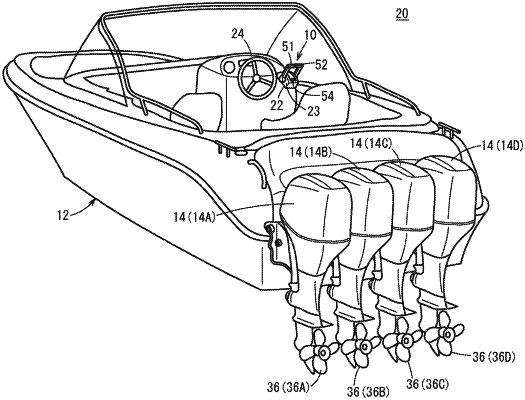| CPC B63H 21/213 (2013.01) [B63H 20/02 (2013.01); F02D 29/02 (2013.01); G05D 1/0011 (2013.01)] | 6 Claims |

|
1. A marine vessel engine rotational speed control device, a marine vessel including a plurality of outboard motors which are mounted on a hull and each of which is equipped with an engine, the marine vessel engine rotational speed control device comprising:
a control unit configured to cause each of the engines of the plurality of outboard motors to transition to a synchronous mode in which the engines are controlled at a same engine rotational speed, based on operation of a change in control, wherein each of the engines is configured to be switched between a neutral position, a forward movement position, and a rearward movement position by a manual operation, and
a first lever and a second lever configured to adjust the respective engine rotational speeds of the plurality of outboard motors in accordance with an amount of operation of the first and second levers at the forward movement position and the rearward movement position, wherein:
the control unit determines beforehand an engine to serve as a reference from among the engines of the plurality of outboard motors; and
when all of the engines have satisfied a transitioning condition to transition to the synchronous mode, the control unit automatically causes transitioning to the synchronous mode in which engine rotational speeds of the engines other than the engine serving as the reference are controlled at an engine rotational speed of the engine serving as the reference, in the synchronous mode, a single lever mode is set in which the engine rotational speeds of all of the engines are allowed to be adjusted by operation of a predetermined one of the first lever and the second lever, and the control unit automatically cancels the synchronous mode when at least one engine from among all of the engines has satisfied at least one cancellation condition that is different from the transitioning condition to transition to the synchronous mode.
|